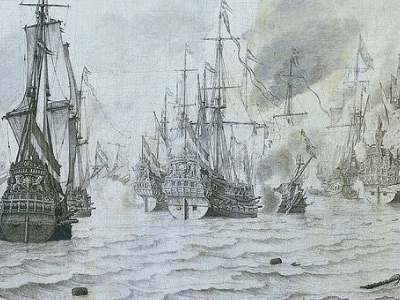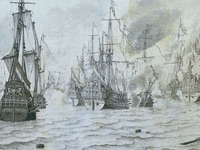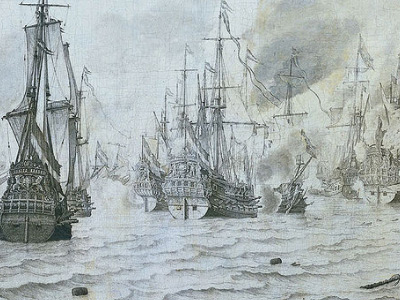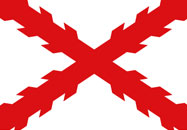Eighty Years' War (1568–1648)

Prelude
In October 1555, Emperor Charles V of the Holy Roman Empire began the gradual abdication of his several crowns. His son Philip II took over as sovereign of the Habsburg Netherlands, which at the time was a personal union of seventeen provinces with little in common beyond their sovereign and a constitutional framework. This framework, assembled during the preceding reigns of Burgundian and Habsburg rulers, divided power between city governments, local nobility, provincial States, royal stadtholders, the States General of the Netherlands, and the central government (possibly represented by a Regent) assisted by three councils: the Council of State, the Privy Council and the Council of Finances. The balance of power was heavily weighted toward the local and regional governments.

Philip did not govern in person but appointed Emmanuel Philibert, Duke of Savoy as governor-general to lead the central government. In 1559 he appointed his half-sister Margaret of Parma as the first Regent, who governed in close co-operation with Dutch nobles like William, Prince of Orange, Philip de Montmorency, Count of Hoorn, and Lamoral, Count of Egmont. Philip introduced a number of councillors in the Council of State, foremost among these Antoine Perrenot de Granvelle, a French-born cardinal who gained considerable influence in the Council, much to the chagrin of the Dutch council members.
When Philip left for Spain The Spanish Empire was a colonial empire governed by Spain and its predecessor states between 1492 and 1976. One of the largest empires in history, it was the first to usher the European Age of Discovery and achieve a global scale, controlling vast territory. It was one of the most powerful empires of the early modern period, reaching its maximum extent in the 18th century. in 1559 political tension was increased by religious policies. Not having the liberal-mindedness of his father Charles V, Philip was a fervent enemy of the Protestant movements of Martin Luther, John Calvin, and the Anabaptists. Charles had outlawed heresy in special placards that made it a capital offence, to be prosecuted by a Dutch version of the Inquisition, leading to the executions of over 1,300 people between 1523 and 1566. Towards the end of Charles' reign enforcement had reportedly become lax. Philip, however, insisted on rigorous enforcement, which caused widespread unrest. To support and strengthen the attempts at Counter-Reformation Philip launched a wholesale organisational reform of the Catholic Church in the Netherlands in 1559, which resulted in the inclusion of fourteen dioceses instead of the old three. The new hierarchy was to be headed by Granvelle as archbishop of the new archdiocese of Mechelen. The reform was especially unpopular with the old church hierarchy, as the new dioceses were to be financed by the transfer of a number of rich abbeys. Granvelle became the focus of the opposition against the new governmental structures and the Dutch nobles under the leadership of Orange engineered his recall in 1564.
The Spanish Empire was a colonial empire governed by Spain and its predecessor states between 1492 and 1976. One of the largest empires in history, it was the first to usher the European Age of Discovery and achieve a global scale, controlling vast territory. It was one of the most powerful empires of the early modern period, reaching its maximum extent in the 18th century. in 1559 political tension was increased by religious policies. Not having the liberal-mindedness of his father Charles V, Philip was a fervent enemy of the Protestant movements of Martin Luther, John Calvin, and the Anabaptists. Charles had outlawed heresy in special placards that made it a capital offence, to be prosecuted by a Dutch version of the Inquisition, leading to the executions of over 1,300 people between 1523 and 1566. Towards the end of Charles' reign enforcement had reportedly become lax. Philip, however, insisted on rigorous enforcement, which caused widespread unrest. To support and strengthen the attempts at Counter-Reformation Philip launched a wholesale organisational reform of the Catholic Church in the Netherlands in 1559, which resulted in the inclusion of fourteen dioceses instead of the old three. The new hierarchy was to be headed by Granvelle as archbishop of the new archdiocese of Mechelen. The reform was especially unpopular with the old church hierarchy, as the new dioceses were to be financed by the transfer of a number of rich abbeys. Granvelle became the focus of the opposition against the new governmental structures and the Dutch nobles under the leadership of Orange engineered his recall in 1564.
After the recall of Granvelle, Orange persuaded Margaret and the Council to ask for a moderation of the placards against heresy. Philip delayed his response, and in this interval the opposition to his religious policies gained more widespread support. Philip finally rejected the request for moderation in his Letters from the Segovia Woods of October 1565. In response, a group of members of the lesser nobility, among whom were Louis of Nassau, a younger brother of Orange, and the brothers John and Philip of St. Aldegonde, prepared a petition for Philip that sought the abolition of the Inquisition. This Compromise of Nobles was supported by about 400 nobles, both Catholic and Protestant, and was presented to Margaret on 5 April 1566. Impressed by the massive support for the compromise, she suspended the placards, awaiting Philip's final ruling.
HISTORY

RESOURCES
This article uses material from the Wikipedia article "Eighty Years' War (1568–1648)", which is released under the Creative Commons Attribution-Share-Alike License 3.0.
© Stories Preschool. All Rights Reserved.











